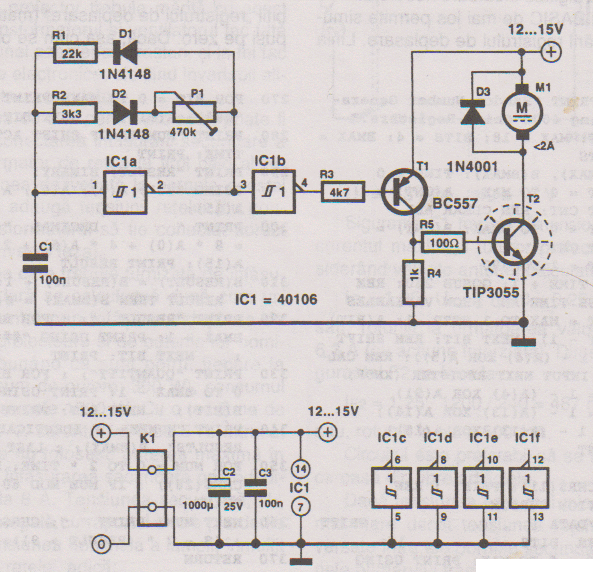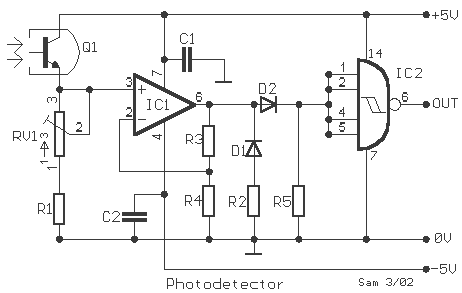
24V flasher circuit

The circuit operates on 24V DC and is designed to alternately flash two 24V bulbs. It functions as an astable multivibrator with a frequency of 1Hz and a duty cycle of 50%. The lamps to be flashed are connected in place of the collector resistor (Rc) in a standard configuration. This circuit utilizes 2N3055 transistors, recognized for their robustness, which can manage collector currents up to 10A, allowing for a diverse range of lamp wattages to be used.
The described circuit is an astable multivibrator configuration that generates a square wave output at a frequency of 1Hz, effectively alternating the flashing of two 24V bulbs. The astable multivibrator is typically composed of two transistors, resistors, and capacitors, which together establish the timing characteristics and switching behavior of the circuit.
In this configuration, the 2N3055 transistors are employed due to their ability to handle significant current loads, making them suitable for driving high-wattage bulbs. The collector of each transistor connects to one of the bulbs, while the emitter is grounded. The base of each transistor is controlled through a resistor network that sets the timing for the switching action. This network allows one transistor to turn on while the other turns off, creating the desired alternating flashing effect.
The circuit's duty cycle of 50% indicates that each bulb is on for half of the total cycle time, ensuring that they flash evenly. The frequency of 1Hz corresponds to one complete on-off cycle per second, which is suitable for applications requiring a visible flashing effect without being overly distracting.
To ensure reliable operation, the circuit should be powered by a stable 24V DC source. Additional components such as bypass capacitors may be included to filter out noise and stabilize the voltage supply. Heat sinks might be necessary for the 2N3055 transistors, as they can generate heat under high load conditions. Proper thermal management will enhance the longevity and reliability of the circuit.
Overall, this astable multivibrator circuit design is versatile, allowing for the connection of various lamp types while providing a simple and effective solution for alternating flashing applications.The circuit shown here works from 24V DC and can flash two 24V bulbs alternatively. The circuit is nothing but an astable multivibrator operating at 1Hz and 50% duty cycle. The lamp to be flashed is connected in place of the collector resistor (Rc) of a typical design. 2N3055 transistors which are well known for their ruggedness are used here. The y can handle collector currents up to 10A. So a wide range of lamps (in terms of wattage) can be connected to this circuit. 🔗 External reference
The described circuit is an astable multivibrator configuration that generates a square wave output at a frequency of 1Hz, effectively alternating the flashing of two 24V bulbs. The astable multivibrator is typically composed of two transistors, resistors, and capacitors, which together establish the timing characteristics and switching behavior of the circuit.
In this configuration, the 2N3055 transistors are employed due to their ability to handle significant current loads, making them suitable for driving high-wattage bulbs. The collector of each transistor connects to one of the bulbs, while the emitter is grounded. The base of each transistor is controlled through a resistor network that sets the timing for the switching action. This network allows one transistor to turn on while the other turns off, creating the desired alternating flashing effect.
The circuit's duty cycle of 50% indicates that each bulb is on for half of the total cycle time, ensuring that they flash evenly. The frequency of 1Hz corresponds to one complete on-off cycle per second, which is suitable for applications requiring a visible flashing effect without being overly distracting.
To ensure reliable operation, the circuit should be powered by a stable 24V DC source. Additional components such as bypass capacitors may be included to filter out noise and stabilize the voltage supply. Heat sinks might be necessary for the 2N3055 transistors, as they can generate heat under high load conditions. Proper thermal management will enhance the longevity and reliability of the circuit.
Overall, this astable multivibrator circuit design is versatile, allowing for the connection of various lamp types while providing a simple and effective solution for alternating flashing applications.The circuit shown here works from 24V DC and can flash two 24V bulbs alternatively. The circuit is nothing but an astable multivibrator operating at 1Hz and 50% duty cycle. The lamp to be flashed is connected in place of the collector resistor (Rc) of a typical design. 2N3055 transistors which are well known for their ruggedness are used here. The y can handle collector currents up to 10A. So a wide range of lamps (in terms of wattage) can be connected to this circuit. 🔗 External reference





